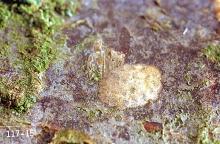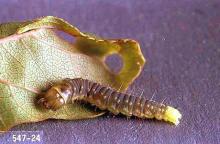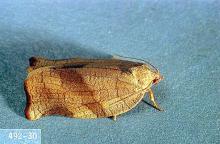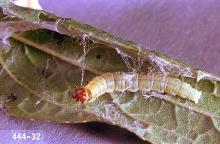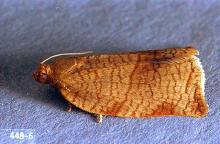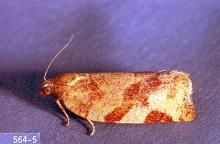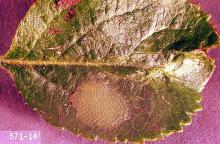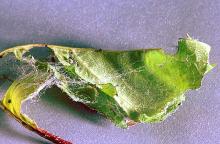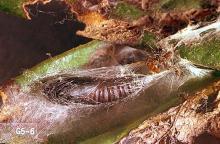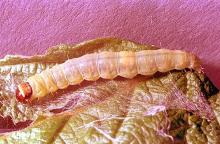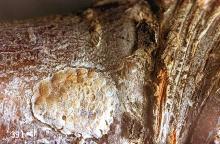European (filbert) leafroller (Archips rosana)
Fruittree leafroller (Archips argyrospila)
Obliquebanded leafroller (Choristoneura rosaceana)
Pandemis leafroller (Pandemis pyrusana)
Pest description and crop damage There are several species of leafroller pests of tree fruits. The larvae of these moth species can use native plants as well as fruit trees as hosts. They all cause similar damage to the trees but differ in their appearance and in their life cycle. These principal leafroller pests of fruit trees are divided into single-generation moths, such as the fruit-tree leafroller and the European leafroller, and two-generation moths, such as the obliquebanded leafroller and pandemis leafroller. Adults of these species measure between 0. 5 to 1 inch in length and range from fawn-color to dark brown with distinctive bands or mottling on the wings. The larvae of these species are all green caterpillars with a light brown to black head, depending on the species. Larvae roll and tie leaves together for shelter and feeding. Mature larvae may be from ¾ inch to a full inch long. They thrash about violently when disturbed and may drop from the leaf suspended by a silken thread. Feeding on growing points on young plants can promote undesirable branching. Larvae also feed on the surface of the fruit, causing deep, russeted scars.
Biology and life history The single-generation leafrollers overwinter as egg masses on twigs and branches. Eggs hatch in spring, as buds are opening, and continue until petal fall. The larvae feed for 4 to 6 weeks, then pupate in the rolled leaves and finally emerge as moths in early summer. The overwintering eggs are laid in July. Two-generation leafrollers overwinter as immature larvae under the bark on scaffold branches of a variety of host plants. Larvae may feed during warm periods in winter but become most active in spring with onset of new growth. They feed for several weeks, and then pupate in rolled leaves. Adult moths emerge in late April to May. These moths mate and lay eggs for the next generation. The next generation hatches in early summer and does the most damage.
Pest monitoring In early spring, observe tree growth for rolled leaves and feeding damage on new growth.
Management-biological control
Very low temperatures in winter and late spring frosts significantly reduce overwintering populations of larvae. Spiders and parasitic wasps, as well as predators like the brown lacewing, greatly reduce leafroller populations throughout the year.
Management-cultural control
Home orchardists: Handpick rolled leaves containing larvae or pupae. Removal of overwintering sites, such as rolled leaves on the ground can reduce next year's population.
Management-chemical control: HOME USE
Dormant spray
- horticultural mineral oil-Some formulations are OMRI-listed for organic use.
Growing-season spray
Warning: Many pesticides are hazardous to bees. Look for bee precautionary statements on product labels and do not use these products during bloom or if bees are foraging in the orchard.
- azadirachtin (neem oil)-Some formulations OMRI-listed for organic use.
- carbaryl-Highly toxic to bees.
- gamma-cyhalothrin-Highly toxic to bees.
- horticultural mineral oil-Some formulations OMRI-listed for organic use.
- insecticidal soap-May require several applications. Some formulations are OMRI-listed for organic use.
- kaolin-Applied as a spray to leaves, stems, and fruit, it acts as a repellant to some insect pests. Some formulations are OMRI-listed for organic use.
- lambda-cyhalothrin-Highly toxic to bees.
- plant-derived essential oils-Some have shown efficacy against leafrollers. Some formulations are OMRI-listed for organic use.
- pyrethrins (often as a mix with other ingredients)-Highly toxic to bees. Some formulations are OMRI-listed for organic use.
- spinosad-Highly toxic to bees. Some formulations are OMRI-listed for organic use.
- zeta-cypermethrin-Highly toxic to bees.
Management-chemical control: COMMERCIAL USE
Dormant and delayed-dormant spray
- horticultural mineral oil (rates vary; check product label)-Use oil at this concentration only in the dormant period. REI varies; check product label. Some formulations are OMRI-listed for organic use.
Prepink spray
- spinetoram (Delegate WG) at 4.5 to 7 oz/A. REI 4 hr.
- spinosad (Entrust SC) at 4 to 8 fl oz/A. REI 4 hr. Results are best when applied at petal fall. May act slowly. OMRI-listed for organic use.
- thiamethoxam/chlorantraniliprole (Voliam Flexi) at 4 to 7 oz/A. Do not apply exceed 14 oz/A of Voliam Flexi per season. REI 12 hr. PHI 14 days.
Bloom spray
- Bacillus thuringiensis var. kurstaki-Check labels for rates. REI 4 hr. Bt products work best if temperatures exceed 50°F over 3 consecutive days. Some formulations are OMRI-listed for organic use.
Spring and summer spray
- Bacillus thuringiensis var. kurstaki-Check labels for rates. REI 4 hr. PHI 0 days. Bt products work best if temperatures exceed 50°F over 3 consecutive days. Apply sprays 14 to 21 days apart. Some formulations are OMRI-listed for organic use.
- flubendiamide+buprofezin (Tourismo) at 10 to 14 fl oz/A. REI 12 hr. PHI 14 days.
- methoxyfenozide (Intrepid 2F) at 8 to 16 fl oz/A. REI 4 hr. PHI 7 days. For each generation, apply when egg hatch begins and before larvae enter fruit. Reapply in 10 to 14 days to ensure complete coverage of rapidly expanding fruits or foliage, or under conditions of high infestation or sustained moth flight.
- spinetoram (Delegate WG) at 4.5 to 7 oz/A. REI 4 hr. PHI 1 day.
- spinosad (Entrust SC) at 4 to 8 fl oz/A. REI 4 hr. PHI 1 day. Results are best when applied at petal fall. May act slowly. OMRI-listed for organic use.
- thiamethoxam+chlorantraniliprole (Voliam Flexi) at 4 to 7 oz/A. Do not apply exceed 14 oz/A of Voliam Flexi per season. REI 12 hr. PHI 14 days.
Resistance management Leafrollers can develop resistance rapidly to chemical controls.

